NorthEast Radio Watch 3/3/2025: Gorbman Retires (Really!)
In this week’s issue… Rochester newsman retires - Mass. AMs on the move - PA FM sold - Corus goes all-Canadian - NAB honors Shulins
Text and photos by SCOTT FYBUSH
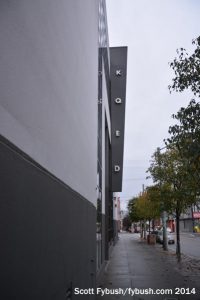
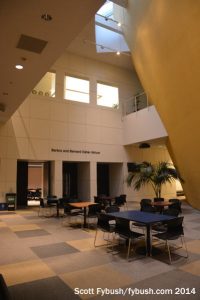
What’s not to love about San Francisco?
OK, it had been raining for several weeks solid when we landed at SFO one night in late December. And yes, we were out in the Bay Area not to do broadcast visits but to attend a family event in Oakland.
But when your internal clock is still on Eastern Time and you’re wide awake the next morning at 6, and there’s a willing engineer on morning-shift duty who’s available for a tour at a big station just a few blocks from where you’re staying, of course you head out into the morning drizzle to see what’s become of a station you last toured way back in 1989, when it was still in a cramped location right by the freeway in what was then a gritty South-of-Market neighborhood.
KQED went through a lot of big changes in the years right after that tour (where, alas, I took no photos – what was I thinking?) It lost the license to its secondary TV service, KQEC (Channel 32), hit a rough financial patch when the economy went south just after it made an expensive purchase of a larger new headquarters building, cancelled a lot of its local TV programming – and then found resounding success in the 21st century as its radio service hit the top of the ratings and the Bay Area swelled with new Silicon Valley fortunes.
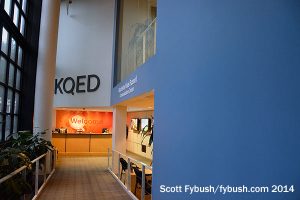 |
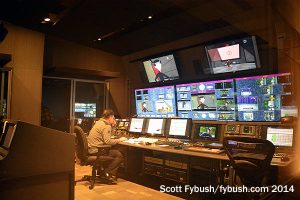 |
KQED’s big building on Mariposa Street in the Mission District, a straight shot down Bryant Street from its old home, may have seemed out of the way when they moved in back in 1992. Today, though, the area is thriving and the station’s real estate has become valuable indeed. (If KQED hadn’t bought the building outright, it would probably be priced out of the neighborhood today and a technology firm would be filling this space.) Come in through the lobby and you’ll head upstairs if it’s broadcast technology you’re looking for: an elevator ride upstairs takes us to a light-filled atrium that leads to TV studios on one side, newsroom and radio studios on the other, with management offices looking down from the floor above.
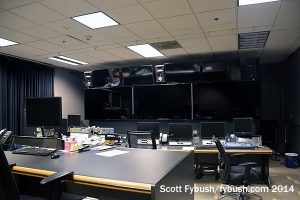 |
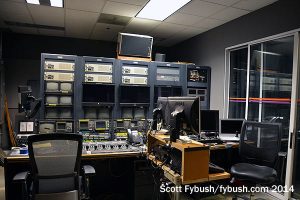 |
This may still be KQED’s “new” building, but at 22 years old, it’s going through a technology overhaul. Those CRT monitors in the camera control area shown above are on the way out, with new HD gear already in place just down the hall. Around the corner, master control now handles not only KQED’s main San Francisco signal (virtual 9, RF 30 from Sutro Tower just to the west) but also KQEH, the South Bay signal (virtual 54, RF 50) that used to be a smaller San Jose-based rival PBS outlet as KTEH. Today, KQEH offers the “KQED Plus” channel on 54.1 and relays other KQED offerings on its subchannels; KQED programming also extends south into the Monterey Bay area on KQET (Channel 25), which had been an even smaller independent operation as KCAH for many years.
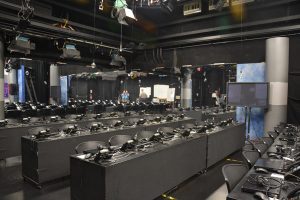 |
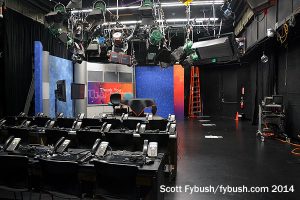 |
Two studios adjoin the control room: in one, the station’s pledge drives are quite literally “done with mirrors,” at least on the wall behind the phone banks that’s one big reflective surface making it look like there are twice as many rows of phones here. The bigger studio next door is used primarily by the latest incarnation of “Newsroom,” KQED’s venerable local public affairs show that was born out of a newspaper strike back in the 1960s.
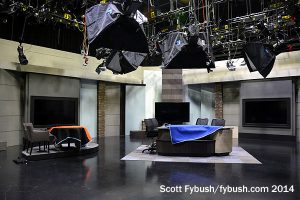 |
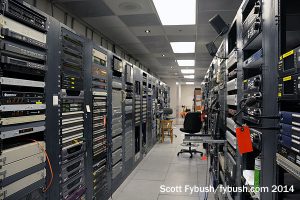 |
KQED-TV’s rack room is just down the hall from the studios and a short walk from the radio engineering area, which leads us around to the radio side of the building facing Bryant Street.
 |
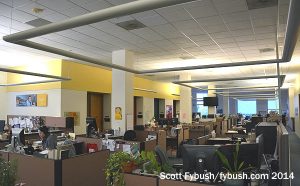 |
In recent years, KQED has become a major news power in the Bay Area, building a big unified radio/TV/digital newsroom that now occupies much of the corner of this floor at Bryant and Mariposa. Several small studios just off the newsroom provide easy access for journalists to record interviews, but the big studio action is down the hall.
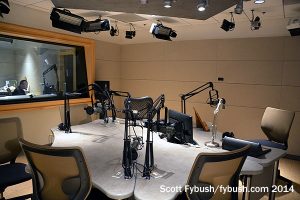 |
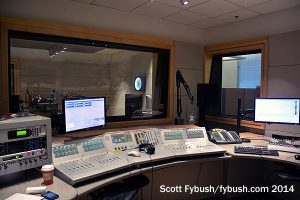 |
One of the keys to the rise of KQED-FM (88.5) is “Forum,” the daily talk show hosted by Michael Krasny. It’s a major user of the largest radio studios here, which line a hallway south of the newsroom. (That desk shown above is neat: it’s in multiple pieces that can be rearranged as needed to make space for big roundtable discussions, intimate interviews or even live performances.)
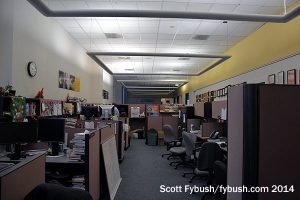 |
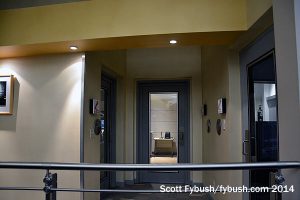 |
Forum’s offices are just outside the FM control room area, where Morning Edition is underway when we poke our heads in for a quick peek. (Check out the Studer consoles, which are nearing the end of their lifespan, though they were as advanced as anything in the world when they were installed.) There’s a news booth next to the control room with excellent line of sight, too.
In addition to this facility, KQED has several satellite newsrooms, including offices in San Jose, the Central Valley and in Sacramento, where KQED-FM is simulcast on KQEI (89.3 North Highlands), which was once a Family Radio station as KEBR-FM.
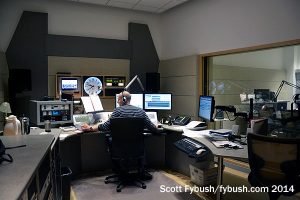 |
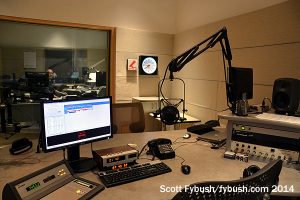 |
If KQED represents one pole of noncommercial radio, the highly professional version that now rivals the big commercial stations in the ratings, we find an example of a very different school of noncommercial FM some 40 miles to the south down I-280.
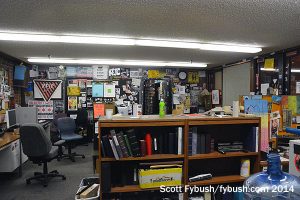 |
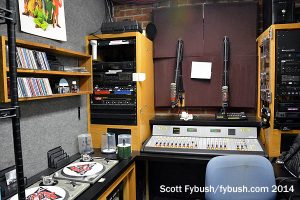 |
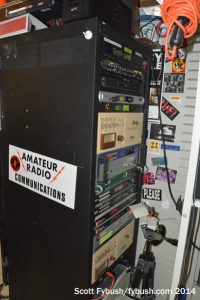
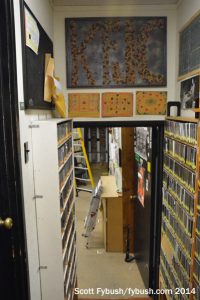
At what’s now known simply as Foothill College, KFJC (89.7 Los Altos Hills) still bears the initials of the school’s old name, Foothill Junior College.
On the air, “KFJC” has a long reputation as one of the West Coast’s most adventurous freeform FM stations; it’s no wonder that it has collaborated often with New Jersey’s WFMU, itself renowned for freeform FM.
It’s late on Christmas Eve Eve when we find our way through the South Bay suburban darkness to the nearly empty Foothill campus, winding our way around to the little row of one-story buildings that includes KFJC’s studio space. We’re here in part because of our admiration of Radio Survivor, the site that’s been busy chronicling noncommercial radio all over the world – and wouldn’t you know it, one of that site’s driving forces also has a Tuesday night slot on KFJC, where she’s known as Cynthia Lombard and where her “Too Cool For School” show is filled with scratchy old dramatic versions of Christmas stories as we drive over for a tour.
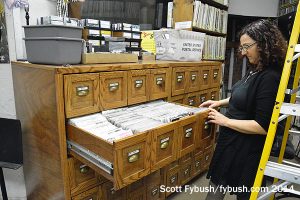 |
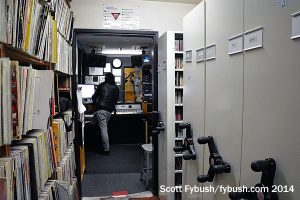 |
KFJC stretches out along a long hallway, anchored at one end by a big office area where every surface is (in good college radio fashion) covered by station and band stickers and album covers and at the other end by a narrow air studio. Along the way, visitors step down (beneath a KFJC logo made out of macaroni!) as the hall passes between more studios (and a small rack room) on one side and a massive record library on the other. There are file drawers of 45s in a space that doubles as a performance studio, with a production studio overlooking it one side and another production room on the other that suffered some nasty water damage and is being repaired.
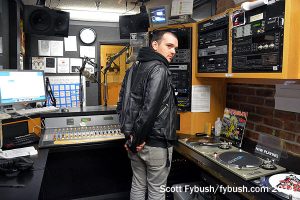 |
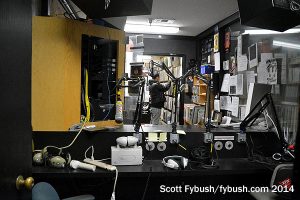 |
And at the end of the hall, the main KFJC studio is so narrow that the jock on one side can’t just walk around the console to get to where the guests sit on the other side; if you want to get from point A to point B, you actually have to backtrack through the record library and performance space to make it to the doorway on the other side of the studio. It’s not very elegant or at all slick, but that’s the point, isn’t it – and a radio dial that has room for both KFJC (and its several counterparts around the Bay) and KQED makes the Bay Area a more interesting place than most to listen to the radio these days.
There aren’t many of us out there who make a habit of visiting radio stations and writing about their facilities and people, so it’s no surprise this tour was followed by a long parking lot chat about what we’d both seen in our travels and a promise to connect again somewhere down the radio road.
Thanks to KQED’s Larry Wood and Steve Pinch and KFJC’s Jennifer Waits for the tour!
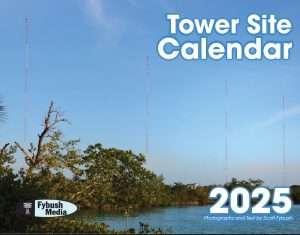
And if you don’t have your Tower Site Calendar, now’s the time!
If you’ve been waiting for the price to come down, it’s now 30 percent off!
This year’s cover is a beauty — the 100,000-watt transmitter of the Voice Of America in Marathon, right in the heart of the Florida Keys. Both the towers and the landscape are gorgeous.
Other months feature some of our favorite images from years past, including some Canadian stations and several stations celebrating their centennials (buy the calendar to find out which ones!).
We have quite a few calendars left and are still shipping regularly.
The proceeds from the calendar help sustain the reporting that we do on the broadcast industry here at Fybush Media, so your purchases matter a lot to us here – and if that matters to you, now’s the time to show that support with an order of the Tower Site Calendar. (And we have the Broadcast Historian’s Calendar for 2025, too. Why not order both?)
Visit the Fybush Media Store and place your order now for the next calendar, get a great discount on previous calendars, and check out our selection of books and videos, too!
Next week: More San Francisco, 2014
In this week’s issue… Rochester newsman retires - Mass. AMs on the move - PA FM sold - Corus goes all-Canadian - NAB honors Shulins
In this week’s issue… Remembering Gary Stevens, Pens' Lange - Public stations team up - NEPM cuts again - More cuts at Corus
In this week’s issue… Townsquare moves studios, cuts staff - Wake up with Mistress Carrie - No flip for WADO - Remembering Maine's Colby, Binghamton's Sommers - Suburban Toronto FM could go silent
In this week’s issue… The FCC's dangerous new path - ABC's big NYC move - VT lawmaker buys stations - King's remaining stations saved - Remembering Boston's Bell, Toronto's Donabie